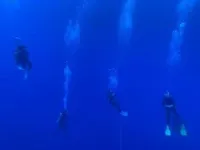(Press-News.org)
PROVIDENCE, R.I. [Brown University] — Tiny chips may equal a big breakthrough for a team of scientists led by Brown University engineers.
Writing in Nature Electronics, the research team describes a novel approach for a wireless communication network that can efficiently transmit, receive and decode data from thousands of microelectronic chips that are each no larger than a grain of salt.
The sensor network is designed so the chips can be implanted into the body or integrated into wearable devices. Each submillimeter-sized silicon sensor mimics how neurons in the brain communicate through spikes of electrical activity. The sensors detect specific events as spikes and then transmit that data wirelessly in real time using radio waves, saving both energy and bandwidth.
“Our brain works in a very sparse way,” said Jihun Lee, a postdoctoral researcher at Brown and study lead author. “Neurons do not fire all the time. They compress data and fire sparsely so that they are very efficient. We are mimicking that structure here in our wireless telecommunication approach. The sensors would not be sending out data all the time — they’d just be sending relevant data as needed as short bursts of electrical spikes, and they would be able to do so independently of the other sensors and without coordinating with a central receiver. By doing this, we would manage to save a lot of energy and avoid flooding our central receiver hub with less meaningful data.”
This radiofrequency transmission scheme also makes the system scalable and tackles a common problem with current sensor communication networks: they all need to be perfectly synced to work well.
The researchers say the work marks a significant step forward in large-scale wireless sensor technology and may one day help shape how scientists collect and interpret information from these little silicon devices, especially since electronic sensors have become ubiquitous as a result of modern technology.
“We live in a world of sensors,” said Arto Nurmikko, a professor in Brown’s School of Engineering and the study’s senior author. “They are all over the place. They're certainly in our automobiles, they are in so many places of work and increasingly getting into our homes. The most demanding environment for these sensors will always be inside the human body.”
That’s why the researchers believe the system can help lay the foundation for the next generation of implantable and wearable biomedical sensors. There is a growing need in medicine for microdevices that are efficient, unobtrusive and unnoticeable but that also operate as part of a large ensembles to map physiological activity across an entire area of interest.
“This is a milestone in terms of actually developing this type of spike-based wireless microsensor,” Lee said. “If we continue to use conventional methods, we cannot collect the high channel data these applications will require in these kinds of next-generation systems.”
The events the sensors identify and transmit can be specific occurrences such as changes in the environment they are monitoring, including temperature fluctuations or the presence of certain substances.
The sensors are able to use as little energy as they do because external transceivers supply wireless power to the sensors as they transmit their data — meaning they just need to be within range of the energy waves sent out by the transceiver to get a charge. This ability to operate without needing to be plugged into a power source or battery make them convenient and versatile for use in many different situations.
The team designed and simulated the complex electronics on a computer and has worked through several fabrication iterations to create the sensors. The work builds on previous research from Nurmikko’s lab at Brown that introduced a new kind of neural interface system called “neurograins.” This system used a coordinated network of tiny wireless sensors to record and stimulate brain activity.
“These chips are pretty sophisticated as miniature microelectronic devices, and it took us a while to get here,” said Nurmikko, who is also affiliated with Brown's Carney Institute for Brain Science. “The amount of work and effort that is required in customizing the several different functions in manipulating the electronic nature of these sensors — that being basically squeezed to a fraction of a millimeter space of silicon — is not trivial.”
The researchers demonstrated the efficiency of their system as well as just how much it could potentially be scaled up. They tested the system using 78 sensors in the lab and found they were able to collect and send data with few errors, even when the sensors were transmitting at different times. Through simulations, they were able to show how to decode data collected from the brains of primates using about 8,000 hypothetically implanted sensors.
The researchers say next steps include optimizing the system for reduced power consumption and exploring broader applications beyond neurotechnology.
“The current work provides a methodology we can further build on,” Lee said.
END
Brown researchers develop brain-inspired wireless system to gather data from salt-sized sensors
The novel approach helps advance wireless sensor technology and paves the way for one day using large populations of inconspicuous sensors in implantable and wearable biomedical microdevices
2024-03-19
ELSE PRESS RELEASES FROM THIS DATE:
New research highlights strong demand for data on personalized risk of preeclampsia
2024-03-19
South San Francisco, Calif. (March 19, 2024) - A new study in BMC Pregnancy and Childbirth finds that objective information about risk of preeclampsia could be key to driving patient behavior change and creates motivation among pregnant patients to follow provider recommendations on prevention, even among those who are medication-hesitant.
Key findings include:
91% of the study participants desired predictive testing for preeclampsia
94% reported they would want blood pressure monitoring at home if found to be at high risk
88% reported they would be more motivated to follow their provider’s medication recommendations if at high risk. This finding was consistent ...
Toxic metal particles can be present in cannabis vapes even before the first use
2024-03-19
NEW ORLEANS, March 19, 2024 — Vapes have often been heralded as a “safer” way to consume either nicotine or cannabis, where legal to do so. But the devices present their own suite of risks that are slowly being revealed as they undergo increasing research and regulation. Now, researchers have discovered that nano-sized toxic metal particles may be present in cannabis vaping liquids even before the vaping device is heated, and the effect is worse in unregulated products.
The researchers will present their results today at the spring meeting of the American Chemical Society (ACS). ACS Spring 2024 is a hybrid meeting being held virtually and in person March ...
Is food waste the key to sustainable, plastic-free diapers and sanitary pads?
2024-03-19
NEW ORLEANS, March 19, 2024 — Once thrown away, disposable items such as diapers and sanitary pads can take hundreds of years to decompose, because their absorbent parts and waterproof layers contain plastics and other synthetic polymers. But now, researchers are replacing these materials with porous components made from protein biomass that is often discarded by the food and agricultural industries. These components are sustainable and biodegradable, and could potentially allow future diapers and sanitary pads to be flushed down a toilet or used as ...
Molecular crystal motors move like microbes when exposed to light
2024-03-19
NEW ORLEANS, March 19, 2024 — At first glance, Rabih O. Al-Kaysi’s molecular motors look like the microscopic worms you’d see in a drop of pond water. But these wriggling ribbons are not alive; they’re devices made from crystallized molecules that perform coordinated movements when exposed to light. With continued development, Al-Kaysi and colleagues say, their tiny machines could be used by physicians as drug-delivery robots or engineered into arrays that direct the flow of water around submarines.
The ...
Conversations in an MR scanner provides a novel view of the brain’s language network
2024-03-19
Researchers have revealed new insights into how the brain processes speech and listening during conversations through advanced investigations using functional magnetic resonance imaging (fMRI). In a groundbreaking study published in the esteemed journal Cerebral Cortex, researchers compared brain activity in individuals while both speaking and listening during natural conversational situations.
Conversational interactions are central to the everyday human experience. During conversation, we use language, together with social, and other cognitive skills to flexibly switch between the roles of speaker and listener. In research on ...
When words make you sick
2024-03-19
In a new book, experts in a variety of fields explore nocebo effects – how negative expectations concerning health can make a person sick. It is the first time a book has been written on this subject.
“I think it’s the idea that words really matter. It’s fascinating that how we communicate can affect the outcome. Communication in health care is perhaps more important than the patient recognises,” says Charlotte Blease, who is a researcher at the Department of Women’s and Children’s Health ...
Removal of incorrect penicillin allergy labels by non-specialist healthcare professional feasible
2024-03-19
Patients who may have been mis-labelled as allergic to penicillin could be safely offered a dose of the oral antibiotic to demonstrate that they could take it without harm, following a new trial.
In a new study published in the Journal of Infection funded by the National Institute for Health and Care Research (NIHR), academics and clinicians ran a study in three UK hospitals to assess the feasibility of non-allergy specialist healthcare professionals delivering direct oral penicillin ‘challenges’, without doing allergy tests, where low risk patients ...
Is your partner’s disturbed sleep keeping you up at night? Letting go of unattainable dreams may keep you both happy in bed
2024-03-19
We all know that getting a good night’s sleep is vital for physical and mental health. Yet many people share a bed with a partner who can’t help disturb their sleep. For example through their insomnia, frequently going to the bathroom, snoring, or a tendency to toss and turn in bed. Unsurprisingly, research has shown that poor sleep can lead to increased anger and decreased satisfaction with the relationship. But can we avoid falling in this trap, short of sleeping in separate bedrooms?
Yes, if we are naturally good – or learn to be so – at goal disengagement, the mental ...
Molecular orientation is key: shining new light on electron behavior using 2-photon photoemission spectroscopy
2024-03-19
Osaka, Japan – Organic electronics is a field that has garnered significant interest in academic and industrial circles due to its potential applications in OLEDs and organic solar cells, offering advantages such as lightweight design, flexibility, and cost-efficiency. These devices are made by depositing a thin film of organic molecules onto a substrate that acts as an electrode, and function by controlling the transfer of electrons between the thin film and the substrate. Therefore, understanding electron behavior at the interface between the substrate ...
Continuous non-invasive glucose sensing on the horizon with the development of a new optical sensor.
2024-03-19
For decades, people with diabetes have relied on finger pricks to withdraw blood or adhesive microneedles to measure and manage their glucose levels. In addition to being painful, these methods can cause itching, inflammation and infection.
Researchers at TMOS, the Australian Research Council Centre of Excellence for Transformative Meta-Optical Systems, have taken an important step towards eliminating this discomfort. Their RMIT University team has discovered new aspects of glucose’s infrared signature and have used this information to develop a miniaturised optical sensor only 5mm in diameter that could one day be used to provide continuous non-invasive glucose monitoring in diabetes ...
LAST 30 PRESS RELEASES:
Why nail-biting, procrastination and other self-sabotaging behaviors are rooted in survival instincts
Regional variations in mechanical properties of porcine leptomeninges
Artificial empathy in therapy and healthcare: advancements in interpersonal interaction technologies
Why some brains switch gears more efficiently than others
UVA’s Jundong Li wins ICDM’S 2025 Tao Li Award for data mining, machine learning
UVA’s low-power, high-performance computer power player Mircea Stan earns National Academy of Inventors fellowship
Not playing by the rules: USU researcher explores filamentous algae dynamics in rivers
Do our body clocks influence our risk of dementia?
Anthropologists offer new evidence of bipedalism in long-debated fossil discovery
Safer receipt paper from wood
Dosage-sensitive genes suggest no whole-genome duplications in ancestral angiosperm
First ancient human herpesvirus genomes document their deep history with humans
Why Some Bacteria Survive Antibiotics and How to Stop Them - New study reveals that bacteria can survive antibiotic treatment through two fundamentally different “shutdown modes”
UCLA study links scar healing to dangerous placenta condition
CHANGE-seq-BE finds off-target changes in the genome from base editors
The Journal of Nuclear Medicine Ahead-of-Print Tip Sheet: January 2, 2026
Delayed or absent first dose of measles, mumps, and rubella vaccination
Trends in US preterm birth rates by household income and race and ethnicity
Study identifies potential biomarker linked to progression and brain inflammation in multiple sclerosis
Many mothers in Norway do not show up for postnatal check-ups
Researchers want to find out why quick clay is so unstable
Superradiant spins show teamwork at the quantum scale
Cleveland Clinic Research links tumor bacteria to immunotherapy resistance in head and neck cancer
First Editorial of 2026: Resisting AI slop
Joint ground- and space-based observations reveal Saturn-mass rogue planet
Inheritable genetic variant offers protection against blood cancer risk and progression
Pigs settled Pacific islands alongside early human voyagers
A Coral reef’s daily pulse reshapes microbes in surrounding waters
EAST Tokamak experiments exceed plasma density limit, offering new approach to fusion ignition
Groundbreaking discovery reveals Africa’s oldest cremation pyre and complex ritual practices
[Press-News.org] Brown researchers develop brain-inspired wireless system to gather data from salt-sized sensorsThe novel approach helps advance wireless sensor technology and paves the way for one day using large populations of inconspicuous sensors in implantable and wearable biomedical microdevices







